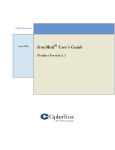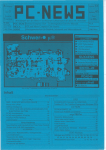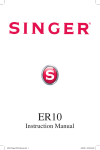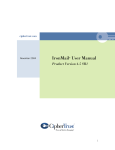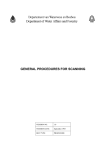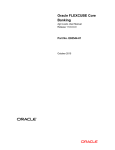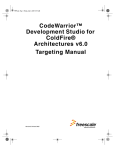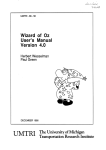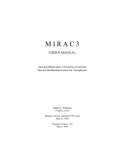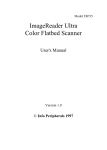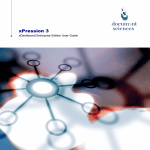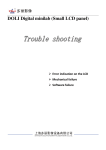Download E` {I
Transcript
US00570645 7A
Ullit€d States Patent [19]
[11] Patent Number:
Dwyer et al.
[45]
[54]
5,706,457
Date of Patent:
Jan. 6, 1998
IMAGE DISPLAY AND ARCHIVING SYSTEM
5,406,384
4/1995 Sakumgi ............................... .. 353/403
AND METHOD
S.6UZ,936
211997 Green et a]. ...... ..
382/305 X
Primary Examiner—Raymond J. Bayer]
[75] Inventors: Douglas A. Dwyer, Brea; James E.
Handy. Huntington Beach; Paul E.
Curry, Placentia; Rick E. P?ugshaupt.
Fullerton; Kevin B. Grant. Anaheim.
all of Calif.
Attorney, Agent, or Firm-Leonard A. Alkov; Wanda K
Benson-Low
ABSTRACT
[57]
A system 10 and methods for acquiring and archiving
images derived from multiple sources with minimal operator
interaction and understanding of the archiving computer 11.
The system 10 and methods provide for reception of digi
[73] Assignee: Hughes Electronics, Los Angeles,
Calif.
tized images via modem 24 from a remote source. and the
[21] Appl. No.: 473,831
Jun. 7, 1995
[22] Filed:
[5 1] Int. (:1.6 ............................ ..
input of images from local sources including a digital
photographic image source 25 such as a digital camera or 35
millimeter digitizing camera data back, an optical scanner
G06F 3/14; G06F 17/40;
G06T 1/60
[52]
US. Cl. ........................ .. 395/349; 395/966; 395/792;
[53]
Field of Search ................................... .. 395/349-351,
395/115; 395/343; 353/403; 358/444
395/346. 965-967, 970.348. 354, 773,
792. 680. 114. 115, 326, 340. 352. 761,
155-157, 159, 161. 144. 147. 650; 353/403.
401, 442. 444; 382/305. 306
References Cited
[56]
U.S. PATENT DOCUMENTS
5,235,680
5,321,520
8/1993 Bijnagte .... ..
6/1994 Inga a a1. ...... ..
395/349 X
395/351
395/610
358/403
5,349,658
9/1994 O’Rourke et a1.
.. 395/349
4,899,136
5,060,135 10/1991
2/1990 Beard
Levineetal.
eta].
23, and digitized images previously stored on magneto
optical disk or digital audio tape. The system 10 also
archives and distributes image and document data to mul
tiple destinations. including a magneto-optical drive 22,
digital or hard disk drive 15, and to laser or photographic
quality continuous tone printers 26. 27. One key aspect of
the system 10 and methods is that the operator is not given
access to the operating system of the computer 11 and can
only perform a predetermined set of functions that corre
spond to graphical icons 30 disposed on the computer
desktop 17 (monitor 12). Each of the icons 30 launches a set
of linked macro functions that
the modem 24.
control data transfer, format the received image data into a
predetermined format, attach textual data to the image ?les.
and automatically archive or print the ?les. Submenus are
provided during operation that permit certain selected
actions related to the macro that is being run.
5,369,508 11/1994 Lech et a1. ........................ .."3s2/305 x
15 Claims, 12 Drawing Sheets
Image Display System
Eile Qisk Tree yiew Qon?gure Iools window ?elp
E‘
A:
4/ 31
[5
3/6
3o
,/ \
[:I
C:
{I
HELP
34
[:1
x32 x
\
D:
32813321111 3211132111
ALBUM
BROWSE]
PRINT!
ARCHIVE!
IMAGE
EDITOR
PHOTO
SHOP
EDIT
PRO
COMM
91111111
SYSTEM
DOS
BACKUP FORMAT
TO TAPE MO DISK
/33\
31391133611913 33911331133113
TRANSFER TRANSFER MODEM TRANSFER
MAC MO
CAMERA/ RECEIVE
FILM
CAMERA
BACK T0 T0 ALBUM DIGITIZER
ARCHIVE
ALBUM
TAPE T0
T0 ALBUM
ALBUM
SCAN
saw
TO
ALBUM
SCAN
GRAY
SCALE
SCAN
COLOR
TO
T0
ALBUM
I 35
35a\
/ 35b
WATCH SCREEN
DOG
SAVER
4 12
ALBUM
\
37 a
SLIDE
SHOW
18::
US. Patent
Jan. 6, 1998
Sheet 2 0f 12
5,706,457
US. Patent
Jan. 6, 1998
Sheet 4 of 12
Fig. 3
OPERATOR
CLICKS
33a
I
5,706,457
f8
ICON
I
5o
BATbé?‘qmmER
51
SCRIPT IS
LAUNCHED
52
SCREEN SAVER
SFI’SII‘PIé’SFO
I———> SELECT EITHER TIFF
OR JPEG TYPE FILES
TO BE STORED.
59
'3 D'SABLED
TEgAgg'w?g'Ts'
OAMERA’SERIAI. #
ARE ExTRAcTEO.
53
54
ALL EMPTY
DIRECTORIES
ARE DELETED
PROMPTS OPERATOR
TO INSERT MAGNETO
OPTICAL DISK
I
55
THE IMAGE EDITOR IS
USED TO COPY
CONTENTS OF THE
DISK TO THE HARD
DISK
6
0
USE IMAGE EDITOR
TO AcQuIRE AN
IMAGE FROM THE
DISK
SAVE IMAGE AS
TIFF OR JPEG IN
NEW DIRECTORY
MORE
IMAGES
?
56
THE NUMBER OF
IMAGES IS
DETERMINED
IMAGE EDITOR
CREATES NEW
ALBUM, THUMBNAILS,
57\
OPERATOR IS
PROMPTED FOR AN
ALBUM DESCRIPTION
AND APPENDS TEXT
IMAGES ARE
DELETED FROM
THE MO DISK
US. Patent
Jan. 6, 1998
Sheet 5 of 12
5,706,457
Fig. 4
33b
OPERATOR
78
CLICKS
I
ICON
I
oPERAToR Is
/
70
71
NORTON
BATCHFIUNNEFI
SCRIPT IS
LAUNCHED
72
SCREEN sAvER
IS DISABLED
73
ALL EMPTY
DIRECTORIES
ARE DELETED
PROMPTED TO
——> SELECT EITHER TIFF
0R JPEG TYPE FILES
TO BE STORED
79
74
TEXT COMMENTS,
DATE, TIME,
CAMERA SERIAL #
ARE EXTRACTED.
80
USE IMAGE EDITOR
TO ACQUIRE AN
IMAGE FROM THE
CAMERA ARCHIVE
PROM PTS OPERATOR
TO CONNECT THE
CAMERA
SAVE IMAGE AS
TIFF OR JPEG IN
NEW DIRECTORY
I
75
THE IMAGE EDITOR IS
USED TO COPY
CAMERA ARCHIVE TO
THE HARD DISK
MORE
IMAGES
?
76
THE NUMBER OF
IMAGES IS
DETERMINED
IMAGE PALS CREATES
NEW ALBUM,
THUMBNAILS, AND
OPERATOR IS
PROMPTED FOR AN
ALBUM DESCRIPTION
AND THE LIGHTING
CONDITIONS WHICH
THE PHOTOS WERE
TAKEN
APPENDS TEXT.
_
IMAGES ARE
DELETED FROM
THE CAMERA
US. Patent
Jan. 6, 1998
Sheet 6 of 12
5,706,457
Hg. 5
33c
OPERATOR
CLICKS
ICON
‘90
91
NORTON
BATCI-IRuNNER
SCRIPT IS
99
CHANGE
DIRECTORY TO
RECEIVED FILES
LAUNCHED
92
SCREEN SAVER
IS DISABLED
93
ALL EMPTY
100
THE NUMBER OF
RECEIVED FILES
IS COUNTED
DIRECTORIES
ARE DELETED
94F PROCOMM PLUS
FOR WINDOWS
IS OPENED
95\
MODEM IS
102
\
®.( EXTRACT FILENAME)
FROM RECEIVED FILE
MULTl PLE
RECEWE
AUTOMATICALLY
INITIALIZED BY
FILES
PROCOMM
‘I03
MESSAGE
INDICATING
RECEIVE MODE IS
104
96
EXTRACT SYS ID
FROM FILENAME
LOOK UP
PASSwOR.
DISPLAYED
97\
98
OPERATORCUCKS
‘°5 gggmgggg
"OK" ON MESSAGE
TO TERMINATE
RECEIvE MODE
106
PROCOMM IS
CLOSED
PROKEY CONTROLS
PC TOOLS WHICH
PERFORMS FILE
DECRYPTION
US. Patent
Jan. 6, 1998
Sheet 7 0f 12
Fig. 5a :30
114
ADD TEXT FILE
TO ALBUM
MULTIPLE IMAGE
FILES ARE
EXTRACTED FROM
DECRYPTED FILE
USING OUINZIP
OPEN TEXT FILE
USING WINDOW'S
WRITE PROGRAM
WAS A TEXT
FILE
RECEIVED
COPY TIME, DATE,
SERIAL NUMBER, AND
COMMENTS FOR IMAGE
TO HARD DISK
'2
109
L
YES
COPY CAMERA SERIAL
NUMBER AND NUMBER
OF IMAGES TO
MEMORY
MULTIPLE
IMAGE
FILES
I
APPEND TO
THUMBNAIL
DESCRIPTION FIELD
117
110
IMAGE EDITOR
IS OPENED
AND CREATES
A NEW ALBUM
111
TITLE OF ALBUM IS
ASSIGNED BY DATA
AND TIME
112
TRANSFER IMAGES
INTO ALBUM
118
DECREMENT
RECEIVE FILE
COUNT
MORE
RECEIVE FILES
?
RUN SCREEN
SAVER, BRING
FILE
RECEIVED
7
NO
UP IDS MENU
AND DISPLAY
COMPLETION
MESSAGE
U.S. Patent
Jan. 6, 1998
333‘
Sheet 8 of 12
5,706,457
Fig. 6
OPERATOR
CLICKS ICON
130
131
135
NORTON
BATCHRUNNER
SCRIPT IS LAUNCHED
132
\
l
TURN OFF THE
[ SCREEN SAVER )
133
l
CALL NOvATAR
PROGRAM TO READ
TAPE
137
I
\
COUNT THE NUMBER
(OF F'LESEQBIAGESI
‘I38
l
\
DIRECTORIES
134
I
\
139
I
\
PROMPT OPERATOR
FOR ALBUM
ALERT OPERATOR:
PROCESSING
DESCRIPTION
COMPLETE
13s
\
ALBUM OF IMAGES
l
PROMPT OPERATOR
TO INSERT THE DAT
140
I
\
TURN
\
N THE s BEEN
OSAVER C
I
FIE-ACTIVATE THE IDS
DESKTOP WINDOW
142
US. Patent
Jan. 6, 1998
33a, 1. 9
5,706,457
Sheet 9 of 12
HQ. 7
150
151
‘
I
NORTON
159
BATCHRUNNER
SCRIPT IS LAUNCHED
IS THE
DOCUMENT
FEEDER
EMPTY ?
I
15%
TURN OFF THE
SCREEN SAVER
160
\
PROMPT OPERATOR
FOR ADDITIONAL
DOCUMENTS
I
1
53
REMOVE EMPTY
DIRECTORIES
161
II
154
l
DOCUM ENTS
PROMPT OPERATOR
FOR DOCUMENT SIZE
162
I
‘55
ANY
ADDITIONAL
YES
\
SET SCAN
CALL IMAGE EDITOR
PROGRAM TO MAKE
ALBUM OF IMAGES
PARAMETERS
II
156
PROMPT OPERATOR TO
PLACE DOCUMENTS IN
SCANNER
II
157
CALL DESKSCAN
PROGRAM TO MAKE
IMAGE FILES
1
158
CHECK DESKSCAN
STATUS FOR PROPER
OPERATION
ALERT OPE RATOR:
PROCESSING
COMPLETE
163
I
TURN ONSAVER
THE SCREE®
164
I
RE-ACTIVATE THE IDS
DESKTOP WINDOW
f
165
166
US. Patent
Jan. 6, 1998
Sheet 10 of 12
Fi g . 8
OPERATOR
39f
'4
SELECTS ALBUM
THEN CLICKS
ALBUM ARCHIvE
ICON
I
‘70
NORTON BATCHRUNNER
SCRIPT IS LAUNCHED
171
EXTRACT ALBUM NAME,
FILENAME, AND
DIRECTORY
‘72
PROMPT OPERATOR "DO
YOU WANT TO MOVE THIS
ALBUM OFF THE COMPUTER
ONTO REMOVABLE DISK?"
173~
174
YES / NO
OPTION
‘76
CREATE A NEW
DIRECTORY PATH ON
THE REMOVABLE DISK,
SELECT THUMBNAIL
IMAGES, SELECT AND
MOvE FILES
177
MESSAGE DISPLAYS
THE PATH NAME
WHERE THE ALBUM
NOW RESIDES
178
5,706,457
US. Patent
Sheet 11 0f 12
Jan. 6, 1998
5,706,457
Fig. 9
399
OPERATOR
SELECTS ALBUM
f RETRIEVE ICON
NORTON BATCHRUNNER
SCRIPT IS LAUNCHED
EXAMINE
181
182
DIRECTORIES ON
REMOVABLE DISK
188
\
OK
PROMPT OPERATOR
"PLEASE INSERT
REMOVABLE DISK."
OK / CANCEL OPTION
REMOVABLE DISK
‘84
CANCEL
REMOVABLE DISK IS
SEARCHED FOR ALL
ALBUM FILES AND
$5 NAME ARE
D‘
185
189
ALBUM DIRECTORY IS
‘YES
CREATED AND COPIED
LAYED To THE
OPERATOR
OPERATOR SELECTS
DESIRED ALBUM BY
CLICKING ON THE NAME
TO THE IMAGE DISPLAY
SYSTEM'S HARD DISK
19o
WORKING DIRECTORY
IS CHANGED TO HARD
v
PROM PT OPERATOR "DO
YOU wANT TO COPY THIS
ALBUM TO THE COMPUTER?"
186
1 87
YES/NO/
CANCEL
DISK
ALBUM SELECTED
IS DISPLAYED ON
SCREEN
CANCEL
192
US. Patent
5,706,457
Sheet 12 of 12
Jan. 6, 1998
Fig. 10
OPERATOR SELECTS
IMAGES TO PRINT
THEN
CLICKS ICON
\
/
200
NORTON
BATCHRUNNER SCRIPT
IS LAUNCHED
201
202
PHOTOSHOP
PREFERENCE
FILE IS COPIED
OPERATOR IS ASK TO
203 \ SELECT PRINTER, PRINT
RESOLUTION, AND
CAPTIONS OPTION
204
IMAGE IS OPENED
USING PHOTOSHOP
I
C RESIZE IMAGE }205
I
TEXT DESCRIPTIONS
206
ARE COPIED TO PRINT)
CAPTION FIELD (OPTION
[ IMAGE IS PRINTED}207
MORE
IMA'PGES
5,706.45 7
1
2
IMAGE DISPLAY AND ARCHIVING SYSTEM
AND METHOD
scanner or by accessing photo data from a DCS 200 digital
camera or a HitchHiker-type digital camera back. for
example. Images may be printed on a laser printer or a
BACKGROUND
photographic quality continuous tone printer.
The present image display system and methods reduces
The present invention relates generally to computer
systems. and more particularly, to an image display system
repetitive operator intensive image processing tasks to a
that provides for multiple source acquisition and multiple
simple clicking of a computer mouse pointer to select an
icon associated with the desired task to be performed. The
destination distribution of image and document data.
There are certain image-related endeavors that require the
present invention provides automated tools speci?cally
designed for image acquisition and archiving. The main
10
acquisition, digitizing. manipulation. transfer and storage of
large volumes of images. Such endeavors include obtaining
menu or desktop of the image display system displays the
tools as icons that are launched by clicking them with the
mouse pointer. Thumbnail images are created for the image
and archiving photographic evidence and news photographs,
and the like. The particular application for which the present
files processed by the automated tools. and incoming ?les
are stored in albums. In addition. text data from camera
archive type ?les (digital camera or camera back) are
extracted from the ?les. The time and date when a picture
was taken along with the serial number of the camera are
invention was developed involves the generation of a large
number of photographs at one location where they are
digitized. and then the transmission of these digitized pho
tographs via modem to a remote location where they are
automatically appended to the thumbnail image ?les.
The following automated functions (tools) are provided
by the image display system and methods: transfer Macin
catalogued and archived
The reception. and archiving of this data is time consum
ing and involves the use of many different software pro
grams. Consequently. it has heretofore been necessary that
the computer operator that transfers and archives the digi
tized photographs be relatively well-trained and have an
tosh magneto-optical camera archive data to an album.
transfer digital camera or camera back data to an album.
receive data via modem and transfer the data to an album.
transfer ?lm digitizer tape data to an album. scan black and
understanding of the different programs that are used to 25
whim image to an album, scan gray scale image to an album.
receive, manipulate and archive the photographic data. The
scan color image to an album. print an image (album menu).
present invention was developed to eliminate the need for a
archive an album to a magneto-optical disk (album menu).
well-trained individual to perform the reception and
archiving tasks. The present invention was also developed to
permit the reception of documents 24 hours a day in an
unattended mode, thus eliminating operator interaction.
Accordingly. it is an objective of the present invention to
and retrieve images from a magneto-optical archive disk
(album menu).
The image display system allows a non-technical operator
with little or no training to process images received from
remote locations, print out the received images. and archive
provide for an image display system that permits multiple
source acquisition and multiple destination distribution of
image and document data.
35
SUIVIMARY OF THE INVENTION
the images onto removable storage media. The available
functions are limited to speci?c image processing functions.
The system is highly automated. By invoking macros. the
image display system saves an operator several hundreds of
key strokes compared with using individual stand-alone
software packages. The macros open multiple software
To meet the above and other objectives, the present
invention is an image display system and methods that
applications. perform speci?c commands required for each
provides for the acquisition and archiving of images derived
application. store image data. and purge excess or redundant
from multiple sources with minimal operator interaction and
data from the system.
understanding of the archiving computer system. The
present invention provides for reception of digitized images
The image display system saves time by performing
repeated operations from a single operator input command.
via modem from a remote location, and the input of images
from local sources including digital cameras and 35 milli
meter digitizing camera data backs. an optical scanner. and
45
There is no single software package that performs the
digitized images previously stored on magneto-optical disk
speci?c tasks. While multiple software packages may be
used to perform the tasks implemented by the present
invention. these packages require extensive technical exper
or digital audio tape. The present invention also archives and
distributes image and document data to multiple
tise and require hundreds of times the amount of operator
input to perform the same tasks. The present invention
allows non-technical operators to perform image processing
destinations. including magneto-optical or other storage
devices and laser or photographic quality continuous tone
tasks that would otherwise require trained technical person
nel. The present invention saves time by eliminating opera
tor required input. Repeated processes are performed auto
printers.
One key aspect of the present invention is that the
operator is not given access to the operating system of the
computer and as such can only perform a predetermined set
of functions that correspond to graphical icons disposed on
the computer desktop (monitor). Each of the icons launches
a set of linked macro functions that
the modem.
55
matically.
The present invention may be readily employed by news
services. newspapers, and magazines, and the like. Photo
graph shops can bene?t from the present invention which
permits processing of all electronic photographs and copy
control data transfer. format the received image data into a
ing and printing thereof. Art stores can bene?t from the
predetermined format. attach textual data to the image ?les.
present invention which permits image storage and
and automatically archive or print the ?les. Submenus are
manipulation, and receipt and processing of new art. Vehicle
toll collection systems can bene?t from the present invention
provided during operation that permit certain selected
which provides a Workstation for manual reading of license
The present invention receives image data via a modem. 65 plate images taken from toll roads.
The automated tools of the image display system save
magneto-optical disk. digital camera. or digital audio tape,
time by emulating the multiple steps required by an operator
for example. Image data may be acquired from a document
actions related to the macro that is being run.
5 .706.457
3
4
to perform speci?c image processing tasks. The following
having 1 gigabyte internal hard disk drive 15, a 5.5 inch high
density ?oppy disk drive 16. a 3.5 inch high density ?oppy
drive 16. the digital audio tape drive. a 120 megabyte
magnetooptical disk drive 22. a Adaptec SCSI driver card.
software packages are used in whole or in part to perform
subtasks of the automated functions. The image display
system integrates a variety of commercial software packages
a Future Domain SCSI driver card, a Diamond Speedstar
such that technical expertise regarding these items are not
required The software packages integrated into a reduced to
practice version of the present system include Adaptec SCSI
Interrogator 1.31 SCSI hardware driver. Adobe Photoshop
2.5.1 image editing. printing. scaling. graphics program.
Corel SCSI 1.13 system backup and retoration utility
10
program. Deskscan II 2.0 scanner. DOS 6.2 operating sys
24:; display driver card, the keyboard 13 and the mouse
pointer 14. The computer processor is interfaced to a NEC
MultiSync SFG color monitor 12. a Hewlett Packard Laser
Jet 4 postscript printer 26. a HP?atbed scanner 23. a Kodak
XLT 7720 continuous tone printer 27. a World Blazer
modem 24 and power adapter. and a 110 volt power con
ditioner and power strip along with power cables are pro
vided. The interconnection and operation of these compo
nents are well understood by those skilled in the art and will
not be described herein.
An important aspect of the present invention is that an
operator is isolated from the operating system of the com
puter 11 because of the way in which the graphical icons 30
are designed. Consequently. the operator is allowed to
tem software. Image Pals 2.0 operating software, Kodak
TWAIN Drivers 4.6 RC 7 camera controller software, Mac
SE 3.2. Norton Desktop 32.2. NovaTAR for DOS 2.01.
QuinZip for Windows, 2.0 image ?le unpacking utility
program. PC Tools for Windows 7.1. Procomm Plus for
Windows modern communications program. Prokey for
Windows 1.0. Prokey for DOS 5.1. SuperQueue 2.20.
WatchDog 703. and Windows 3.1.
20
perform only a predetermined set of image processing
BRIEF DESCRIPTION OF THE DRAWINGS
functions that correspond to the graphical icons 30. Each of
The various features and advantages of the present inven
tion may be more readily understood with reference to the
perform a variety of tasks. including initializing the modem
following detailed description taken in conjunction with the
accompanying drawings. wherein like reference numerals
the icons 30 launches a set of linked macro functions that
25
designate like structural elements. and in which:
FIG. 1 shows a block diagram of an image display system
in accordance with the present invention;
24. controlling data transfer from the remote source by way
of the modem 24. or from the scanner 23. digital camera 25
or data back 25. the digital audio tape drive 21. or the
magneto-optical disk drive 22. formatting received image
data into a predetermined format. attaching textual data to
the image ?les. and automatically archiving or printing the
FIG. 2 shows a main display screen or menu of the image 30 ?les. These functions are performed by executing macros
that operate the commercial software programs. Another
important aspect of the present invention is that these
macros are designed to operate the cormnercial programs in
display system of FIG. 1;
FIG. 2a shows an album menu of the image display
system of FIG. 1; and
FIGS. 3-9 are ?ow diagrams illustrating procedures
implemented by the automated tools of the image display
a consistent manner. This prevents the operator from elimi
35
system and that are used to process image input and output
nating critical processing steps and processing image data
with an inconsistent format. Submenus are presented dining
operation that permit certain selected actions related to the
function or operation that is being performed
data.
FIG. 10 is a flow diagram illustrating a macro performed
The image display system 10 provides acquisition of
by achieving an image printing icon.
DETAILED DESCRIPTION
image and document data from multiple sources and distri
bution of the data to multiple destinations. The image
display system 10 can receive image data via the modem 24.
Referring to the drawing ?gures, FIG. 1 shows a block
diagram of an image display system 10 in accordance with
the present invention. The image display system 10 is
magneto optical disks. the digital camera 25. or digital audio
tapes that contain digitized ?lm images. Image data may be
acquired using the scanner 23 or by accessing photographic
45
comprised of a computer 11. such as an IBM compatible
data from the digital camera 25 such as a DCS 200 camera
computer 11 containing an Intel 486 processor running at 66
MHz. for example. The computer 11 includes an internal
25. or a digital data back 25 such as a HitchHiker. Images
may be printed out on either the laser printer 26 or the
hard disk drive 15. one or more ?oppy disk drives 16. a
photographic quality continuous tone printer 27.
digital audio tape (DAT) drive 21. and a magneto-optical
FIG. 2 shows a main display screen or menu 18 of the
(MO) disk drive 22. Connected to the computer 11 are a
image display system 10 of FIG. 1. The image display
scanner 23 for scanning images into the computer 11. a
telephone or wireless modem 24 for receiving image ?les
system 10 provides automated tools 30 that are speci?cally
from a remotely located source. a monitor 12, a keyboard 13.
a mouse pointer 14. and laser and continuous tone printers
menu 18 of the image display system 10 displays the tools
designed for image acquisition and archiving. The main
55
as a digital camera 25. or a digital data back 25 that attaches
to a camera to permit transfer of images therefrom. The
mouse pointer 14 has a cursor 15 that is displayed on the
monitor 12 that is used to select graphical icons 30 disposed
on a computer desktop 17 (screen) that are representative of
?les are extracted The time and date when a picture was
taken along with the serial number of the camera 25 are
automatically appended to the thumbnail images 41.
hard disks 31. ?oppy disk drive 16. applications 32. image
acquisition tools 33. utility functions 34. 35. 36. and a slide
show display function 37.
Areduced to practice version of the image display system
10 comprises a ZEOS 486 66 MHz computer processor
30 as icons 30 that are launched by clicking on them with the
mouse pointer 14. Images received using the automated
tools automatically create thumbnail images 41 (shown in
FIG. 2a) and store the incoming ?les as albums 38 (shown
in FIG. 2a). In addition. text data from camera archive type
26. 27. An interface 25a is provided for connecting the
computer 11 to a digital photographic image source 25 such
65
FIG. 2a shows an album menu 18a of the image display
system 10. The thumbnail images 41 are displayed on the
album menu 18a shown in FIG. 2a. The thumbnail images
41 provide an operator with a quick look at all new images
without having to open each ?le. The albums 38 can be
5,706,457
5
6
archived and retrieved on removable magneto-optical disks
using automated tools in the album menu 18a.
The automated tools 30 of the image display system 10
launches 55 the image editor 32b which is used to copy the
contents of the magneto-optical disk to the desktop 17. The
number of images contained on the magneto-optical disk is
determined 56. The operator is then prompted 57 for an
album description or name. and is prompted 58 to select the
type of image ?le that is to be stored. The image editor 32b
include system backup to digital audio tape (icon 340). DOS
format of a magneto-optical disk (icon 34b). transfer Macin
tosh magneto-optical camera archive data to an album (icon
has been preprogrammed to extract 59 or read 59 text
comments. the date, the time. and the camera serial number
33a). transfer digital camera 25 or camera back 25 data to an
album (icon 33b). receive data via modem 24 and transfer
the data to an album (icon 330). transfer ?lm digitizer tape
from the magneto-optical disk. The image editor 32b has
to an album (icon 33d). scan black and white image to an 10 been programmed to acquire 60 or read 60 an image from
album (icon 33c). scan gray scale image to an album (icon
33)‘). scan color image to an album (icon 33g). print an image
(icon 39d, album menu 18a). archive an album (icon 39];
album menu 18a). and retrieve images from magneto-optical
disk (icon 39g, album menu 18a). search albums (icon 39c,
album menu 18a). print document (icon 390, album menu
18a). and a help menu (icon 36. main menu 18 and icon 39h,
album menu 18a).
The software packages that are integrated into a reduced
to practice version of the system 10 include Adaptec SCSI
Interrogator 1.3 l which is a hardware driver that controls the
SCSI interface. an Adobe Photoshop 2.5.1 program which is
the magneto-optical disk. and the read image is saved 61 as
a TIFF or JPEG image in a newly created directory. The
macro cycles 62 to continue to read all image ?les contained
in the magneto-optical disk. Once all images have been read
and stored in the directory. the image editor 32b creates 63
a new album 38. thumbnail images 41 for each image in the
album 38. and appends the extracted text data 59 to the
20
thumbnail images 41. Once the images are stored in the new
album 38. the images are deleted 64 from the magneto
optical disk. and the macro ends 65.
FIG. 4 is a ?ow diagram illustrating the macro performed
by activating the transfer camera to album icon 33b. The
an image editing. printing. scaling. graphics program. a
Norton Desktop program has been used to create a Norton
Corel SCSI 1.13 utility program which is a system backup
BatchRunner script 61 that is launched 60 by clicking the
icon 33b. The BatchRunnm' script is programmed to perform
and restoration utility program. a Deskscan II 2.0 program 25
the speci?c tasks shown in FIG. 4. First. the screen saver 35b
which operates the scanner 23. a DOS 6.2 operating system
is disabled 72. Then all empty directories are deleted 73. A
which is part of the computer operating system and allows
screen display is generated that prompts 74 the operator to
other programs to ran. an IrnagePals 2.0 program which is an
connect the camera or camera back 25. The macro then
image editor and album creator, Kodak TWAIN Drivers 4.6
launches 75 the image editor 32b which is used to copy the
RC 7 which provide camera control for the Photoshop and
ImagePals software. a MacSEE 3.2 disk utility program
contents of the camera or camera back 25 to the desktop 17.
allows the computer to read from and write to Macintosh
The number of images contained on the magneto-optical
disk is determined 76. The operator is then prompted 77 for
an album description or name. and for lighting conditions
under which the photographs were taken. The operator is
then prompted 78 to select the type of image ?le that is to
be stored. The image editor 32b has been preprogrammed to
disks. a Desktop 32.2 utility program which is a utility
program that is used to create and run desktop and batch ?le
macros. a NovaTAR for DOS 2.01 ?le transfer program is a 35
utility program that reads to and writes to digital audio tape,
a QuinZip for Windows 2.0 utility program which is a utility
program that unpacks individual image ?les from a modem
receive ?le. a PC Tools for Windows 7.1 utility program
which is a utility program that decrypts image ?les, a
Procomm Plus for Windows communication program which
extract 79 or read 79 text comments. the date. the time. and
the camera serial number from the camera or camera back
25. The image editor 32b has been programmed to acquire
80 or read 80 an image from the camera or camera back 25.
is a communications program that controls the modem 22. a
and the read image is saved 81 as a TIFF or J'PEG image in
Prokey for Windows 1.0 utility program and a Prokey for
DOS 5.1 utility program which are utility programs that
a newly created directory. The macro cycles 82 to continue
to read all image ?les contained in the camera or camera
allow a user to write macros using mouse points and clicks, 45 back 25. Once all images have been read and stored in the
directory. the image editor 32b creates 83 a new album 38.
SuperQueue 2.20 which spools print jobs to printers 26. 27,
a WatchDog 703 security program which is a security
thumbnails 41 for each image in the album 38. and appends
program that provides user logon at power up. and a
Windows 3.1 operating system which is part of the operating
the extracted text data 79 to the thumbnail images 41. Once
the images are stored in the new album 38. the images are
system and allows other programs to run on the computer 11.
Flow diagrams are shown in FIGS. 3-10 that illustrate
deleted 84 from the camera or camera back 25. and the
macro ends 85.
some of the automated tools 30 used in processing image
input and output ?les and data. The balance of the icons 30
FIGS. 5 and 5a show a ?ow diagram illustrating the
macro performed by activating the transfer modem receive
to album icon 33c. Referring to FIG. 5. the Norton Desktop
that are not speci?cally discussed have simple macros or are
application icons or aliases that correspond to the speci?c
task. The construction of these icons 30 is considered routine
to those skilled in the art.
FIG. 3 is a ?ow diagram illustrating the macro performed
by activating the transfer Macintosh magneto-optical carn
era archive to album icon 33a. The Norton Desktop progam
has been used to create a Norton BatchRunner script 51 that
is launched 50 by clicking the icon 330. The BatchRunner
script is programmed to perform the speci?c tasks shown in
program has been used to create a Norton BatchRunner
script 91 that is launched 90 by clicking the icon 33b. The
BatchRunner script is programmed to perform the speci?c
tasks shown in FIGS. 5 and 50. First. the screen saver 35b
is disabled 92. Then all empty directories are deleted 93. The
macro then launches 94 the modem software. such as
Procomm Plus for Windows. The modem 24 is automati
cally initialized 95 to receive single and multiple ?les. and
all ?les are transferred to the hard disk drive 15. During ?le
transfer, the operator is prompted 96 with a message dialog
FIG. 3. First. the screen saver 35b is disabled 52. Then all
empty directories are deleted 53. A screen display is gener 65 box indicating that the system 10 is in a receive mode. Once
ated that prompts 54 the operator to insert a magneto-optical
?le transfer has been completed. the operator is prompted 97
disk into the magneto-optical disk drive 22. The macro then
to click “OK” to terminate the receive mode. and the modern
5.706.457
7
8
transfer software is closed 98. The directory is then changed
99 to the directory that contains the received ?les. The
number of received ?les is counted 100. The operator is then
prompted 101 to indicate if any ?les were received 101 and
the macro branches along two different paths. depending
32b is then run to construct 138 an album 38 containing the
images. Once all images have been read and stored in the
album 38. the operator is alerted 139 with a screen prompt
that processing has been completed. The screen saver 35b is
then run 140. the desktop 17 is displayed 141. and the macro
ends 123.
FIG. 7 is a ?ow diagram illustrating the macro performed
by activating of the scan black and white. gray scale. or color
image to album icon 33a. The Norton Desktop program has
upon whether a yes or no answer was indicated In the event
that no ?les have been received. then the program jumps (C)
to a point where it runs the screen saver 35b, the desktop 17
is displayed, and a completion message is displayed to the
operator. and the macro ends 123.
been used to create a Norton BatchRunner script 151 that is
If ?les were received. the macro is programmed to extract
102 the ?le name from a received ?le. extract 103 the system
ID number from the ?le name. and look up 104 a password
from a database of passwords that are used to implement
launched 150 by clicking the icon 33c, 331i 33g. The
BatchRunner script is programmed to perform the speci?c
decryption of the received ?le. Once a correct password has
display is generated that prompts 154 the operator for the
been determined. the macro launches 105 a macro pro
grammed using the Prokey for Windows utility program.
size of the document that is to be scanned. The scanning
parameters 155 are then set in response to data entered by
The Prokey macro is used to automatically perform mouse
the operator. The operator is prompted 156 to place docu
implemented or keyboard-implemented commands, and is
used because of the speci?c program used to perform
decryption requires such commands to be entered. The
tasks shown in FIG. 7. First. the screen saver 35b is disabled
152. Then all empty directories are deleted 153. A screen
20
ments into the scanner 23. A document scanning program.
such as the Deskscan scanner operating software. for
example. is then run 157 to create the image ?les. The macro
Prokey macro controls 106 a ?le decryption program. PC
Tools for Windows. to decrypt the received ?le.
Referring to FIG. 5a, once decryption of the received ?le
is completed. the image ?les contained in the received ?le 25
automatically checks 158 the status of the scanning program
for proper operation. After each document is scanned. the
are extracted 107 by launching the QuinZip program. To
156 to place additional documents in the scanner 23 and the
intervening steps are repeated. If the document feeder is
empty. then the operator is prompted 160 for additional
extract the image ?les. it is ?rst determined 108 if a text ?le
was received. If a text ?le was received, the camera serial
document feeder is checked 159 to see if it is empty. If the
document feeder is empty. the operator is again prompted
documents. If additional documents are to be scanned. the
109 to memory. This step is bypassed if no text ?le was 30 operator is again prompted 156 to place additional docu
ments in the scanner 23 and the intervening steps are
received Then. the image editor 32b creates 110 a new
number and number of images contained in the ?le is copied
album 38. and the title of the album 38 is assigned 111 by
date and time. The image editor 32b has been programmed
to acquire 112 the images and store them in the album 38.
It is again determined 113 whether or not a text ?le was 35
received If a text ?le was received. the text ?le is added 114
to the album 38. Then. the text ?le is opened 115 using a
writing program that is part of Windows operating system.
for example. The writing program has been preprogrammed
to copy 116 text comments. the date. the time. and the serial
number of the camera 25 to the hard disk drive 15. The
39f is used to archive an album 38 to a removable disk. The
operator selects an album 38 for archiving and then clicks
170 on the album archive icon 39)‘. The Norton Desktop
copied data is then appended 117 to the thumbnail descrip
tion ?eld of the image ?le. and the program loops to extract
this data from all image ?les. Once the text data has been
extracted from all ?les. the text ?les are closed 18. The
received ?le count is then decremented 119. and it is
determined 120 if any more ?les have been received If
additional ?les have been received. the program jumps (B)
repeated. If there are no additional documents. the image
editor 32b is run 162 to create an album 38 of the images.
After the album 38 is created. the operator is prompted 163
that processing is complete. The screen saver 35b is then run
164. the desktop 17 is displayed 165. and the macro ends
166.
FIG. 8 is a ?ow diagram illustrating the macro performed
by activating the album archive icon 39f located on the
album menu 18a shown in FIG. 2a. The album archive icon
program has been used to create a Norton BatchRunner
45
script 171 that is launched when the icon 39f is clicked. The
album name. ?le name and directory are extracted 172 from
the selected album 38. The operator is then prompted 174 to
determine if the selected album 38 is to be removed from the
hard disk drive 5 to the removable disk. It a no answer is
back to extract 102 the ?le name from the next received ?le
and the processing continues until there are no more ?les to 50 selected 174. then the macro ends 175. If a yes answer is
selected 176. then a new directory path on the removable
process. Once it is determined that no more ?les have been
disk is created. the thumbnail images 41 for the album 38 are
received. the screen saver 35b is run. the desktop 17 is
selected. and the image ?les and thumbnail images 41 are
displayed. and a completion message is displayed to the
moved to the removable disk. Once archiving is complete, a
operator. and the macro ends 123.
FIG. 6 is a ?ow diagram illustrating the macro performed 55 message is displayed 177 indicating the path name where the
album 38 resides on the removable disk. and the macro ends
by activating the transfer ?lm digitizer tape to album icon
178.
‘
33d. The Norton Desktop program has been used to create
FIG. 9 is a ?ow diagram illustrating the macro performed
a Norton BatchRunner script 13] that is launched 130 by
clicking the icon 33d. The BatchRunner script is pro
by activating the album retrieve icon 39g. The album
grammed to perform the speci?c tasks shown in FIG. 6.
retrieve icon 39g is used to retrieve an archived album 38
First. the screen saver 35b is disabled 132. Then all empty
directories are deleted 133. A screen display is generated that
prompts 134 the operator for an album description or name.
retrieve icon 39g. The Norton Desktop program has been
and to insert 135 the digital audio tape into the DAT drive
21. The NovaTAR transfer program has been prepro
grammed so that it reads 136 the tape. The number of image
?les contained on the tape is counted 137. The image editor
from a removable disk. The operator clicks 180 on the album
used to create a Norton BatchRunner script 181 that is
launched when the icon 39g is clicked. The directories on all
removable disks are ?rst examined 182. The operator is
prompted to determined 183 whether a removable disk has
been inserted into the disk. If a removable disk is in not the
5 .706,45 7
9
10
disk drive. then the operator is prompted to insert the
are icons 30 to access application software to perform image
editing (icons 32b, 32c). archiving (icon 32a). and utility
removable disk into the drive 22 and continue or cancel the
operation. If a removable disk is in the disk drive. then it is
searched 184 for all album 38 and the names of the albums
38 are displayed to the operator. The operator then selects
185 a desired album for retrieval by clicking on the name of
the album 38. The operator is prompted 186 to determine if
the selected album 38 is to be copied to the hard disk drive
15. The operator is then prompted 187 to determine if the
functions (icons 34a. 34b). A brief description of each icon
30 is presented below and with appropriate reference to
FIGS. 3-10. The step-by-step operation of each tool is
described in greater detail below.
All functions of the image display system 10 are initiated
from the desktop 17 by clicking the mouse pointer 14 on any
album is to be retrieved or not or to cancel the entire macro. 10
If the selected album 38 is to be retrieved, the directory for
the retrieved album 38 is created and copied 189 to the hard
disk drive 15. The working directory is then changed 190 to
the album directory on the hard disk drive 15. The retrieved
album 38 is displayed 191 on the album menu 18a, and the
utility. which are represented by the ditferent icons 32. 33.
34. 35. 36. 37.
Several tools perform speci?c functions. which include
acquiring image data from the digital camera 25. the digital
camera back 25. the scanner 23. or the remote system (such
macro ends 192. If the selected album 38 is not to be
retrieved. the selected album 38 is displayed 191 on the
album menu 18a, and the macro ends 192 without retrieving
the album. If a decision is made to cancel the macro and not
retrieve the album. then the macro ends 192.
FIG. 10 is a ?ow diagram illustrating the macro per
of the icons 30 to activate a desired application. function. or
20
as a photo transmit case). The functions of the image display
system 10 automate common image acquisition tasks such
as scanning documents and acquiring camera images. These
functions of the image display system 10 are used whenever
possible to reduce errors and maintain the image organiza
tion within the system 10. All functions adhere to ?ling
conventions established for the image display system 10.
thereby ensuring that all acquired data may be readily used
by other functions.
formed by activating the image printing icon 39d. The
operator selects images that are to be printed and then clicks
200 on the image printing icon 39d. The Norton Desktop
The help icon 36 allows an operator access to a help
program has been used to create a Norton BatchRunner 25
menu. The help menu is accessed by clicln'ng on the help
script 201 that is launched when the icon 39d is clicked. A
icon 36. In the help menu. an operator clicks on highlighted
preference ?le for an image editing program. such as Pho
words to obtain more information about the particular item.
toshop 32c, for example. is copied 202. the operator is
The help menu is conventional and is similar to help menus
prompted 203 to select a printer. print resolution and cap
available in most popular software packages.
tion. An image is opened 204, using Photoshop 320 for
example. The image is resized 205 by scaling it to produce
The ImagePals album program is a standalone program
that provides the capability to organize and manage docu
ment and image ?les. The use of the ImagePals image
editing software to construct macros is easily understood
an image that is 8.5 inches by 11 inches. Optionally. text
descriptions are copied 206 to the print caption ?eld of the
image. The image is then printed 207. If there are additional
images. then the next image is opened 204. resized 205. the
test descriptions are optionally copied 206. the image is
with reference to its user manual and operating instructions.
The macro associated with the album icon 320 is con?gured
so that ?les are grouped into albums. Multiple albums are
printed 207. This process continues until there are no more
accessible from the album desktop 180 that is displayed by
clicking the album icon 32a. Files in albums 38a, 38b, 380
images. whereafter the macro ends 209.
A more detailed description of the operation of the system
follows. The image display system 10 has been con?gured
are visible as thumbnail images that are representations of
the stored images.
The ImagePals image editor program 32b is a standalone
program that provides the capability to acquire documents
to only allow use by authorized users (those with
passwords). This is done by invoking the WatchDog security
program. After the computer 11 is booted up. a log-on menu
is displayed (not shown). There are two valid user types:
super and operator. The functionality and differences of each
operator are described below. The type of user is entered and
then a password is entered. An operator is routed directly to
the desktop menu 18 displayed on the monitor 12 after
entering his or her password. There is restricted access to the
disk drives 16. 21. 22 and portions of the hard drive 16. This
prevents the modi?cation of or undesirable removal of
and images from the scanner 23. the digital camera 25. or the
45
digital camera back 25. Image and document ?les may be
manipulated. enhanced. and printed by launching this icon
32b. The ImagePals image editor 32!: supports TIFF and
J'PEG ?le formats. Black and white. gray scale. and color
images may also be processed using the ImagePals image
50
system software. The operator is given full capability of
performing the automated image processing functions pro
vided by the image display system 10.
editor 32b.
The Photoshop software program 32c is an image editor
that is a standalone program that provides the capability to
acquire documents and images from the scanner 23. the
digital camera 25. or the digital camera back 25. Image and
A super-type user is a system administrator or support 55 document ?les may be manipulated. enhanced. and printed
from within this program. The Photoshop software program
person. A super-type user has access to all of the software
32c supports TIFF and JPEG ?le formats.
Procomm modem transfer software 32d is provided as a
stand alone application for manually transmitting or receiv
ing program data using the modem 24.
A system backup icon 34a is provided to back up the hard
used on the image display system 10. After logging on and
entering an appropriate password. the super-user is pre
sented with a super-user menu. The super-user can choose to
use the icons 30 displayed on the desktop as with the
operator. Windows program managers. or use the disk
disk drive 15 to a digital audio tape that is inserted into the
digital audio tape drive 21. The tape is inserted into the
digital audio tape drive 21 and the function is activated from
operating system (DOS). 0n the desktop of the image
display system 10. the super user also is given access to all
tools and access to all of the disk drives 15, 16. 21. 22.
The desktop of the image display system 10 comprises the
65
the desktop 17 by clicking the system backup icon 340. The
desktop menu 18 that presents the tools to an operator to
system backup icon 34a calls a macro that employs the Corel
perform several image input operations. In addition. there
SCSI program to perform the tape backup.
5,706,457
11
12
The MO disk format icon 34b is provided to DOS format
a magneto-optical disk inserted into the magneto-optical
disk drive 22. This function DOS formats the magneto
optical disk. It only formatted blank. corrupted. or
icon 35b is also provided that automatically blanks the
Macintosh-formatted disks. It cannot be used to erase a
images acquired or received by the image display system 10.
previously DOS formatted magneto-optical disk.
The slide show is launched by clicking on the slide show
icon 37. The escape key is used to exit from this application.
display screen of the monitor 12 when the system 10 has not
been in use for a preset amount of time.
A slide show icon 37 calls a macro that displays sample
The MO disk to album icon 330 calls a macro that
transfers data from a Macintosh magneto-optical disk to an
album 38. The MO disk to album icon 33a calls a macro that
executes a DOS batch ?le to format the M0 disk with the
correct attributes. This icon 33a transfers images from a
camera archive ?le on the Macintosh formatted magneto
optical disk to the album 38. The images in the archive are
The slide show terminates in the album menu 18a and exits
the album menu 18a to return to the desktop 17 of the image
display system 10.
Automated desktop icons 30 are provided in the album
menu 180. These include an image print icon 39d, an album
archive icon 39f and an album retrieve icon 39g. The image
individually acquired and then transferred to the album 38.
print function calls a macro that allows an operator to select
one or multiple images from an image album 38 and send
Time. date. and serial number of the camera 25 are also
extracted and copied to a description ?eld of each thumbnail
them to the printer 26. 27. There is no maximum number of
images that can be printed at one time, which is a limitation
image 41.
The transfer camera to album icon 33b calls a macro that
transfers data from the digital camera 25 and digital camera
back 25 to an album 38. This tool transfers images from a
Kodak Camera Archive ?le from either the digital camm'a 25
or the HitchHiker-type digital camera back 25 to the album
38. Time. date. and serial number of the camera 25 are
extracted and copied to the description ?eld of each thumb
nail image. The time. data. serial number of the camera 25
and other may be printed with each image as the descriptor
?eld.
20
25
The modern receive icon 330 calls a macro that transfers
data received over the modem 24 to an album 38. This tool
receives images from a remote source via phone lines. for
in some software packages. such as Photoshop. for example.
This function resizes (increases or decreases) each image to
best ?t an 8X11 sheet of paper. The image archive function
allows an operator to move an entire album 38 of images to
a removable disk media. This function copies the entire
directory structure to the archive disk media. Thumbnail
images 41. images. and text ?les are moved. The data is
completely removed from the hard disk drive 15 of the
image display system 10. The image retrieve function
searches through removable media for image albums 38 that
have been archived The operator is given an option of
working from the removable media or copying the albums
38 or images to the hard disk drive 15. This function is used
example. unconcatenates the data into individual images,
separates images contained in the ?le. and then stores the
images in the album 38. Time. date. and serial number of the
in conjunction with the album archive icon 39f to provide a
removable indexed archive system for large numbers of
camera 25 are extracted. if available. and are copied to the 35
Thus. an image display system that provides for the
acquisition and archiving of images derived from multiple
description ?eld of each thumbnail image 41. The image
display system 10 can receive. decrypt. and store approxi
mately 50 images per hour over standard telephone lines.
Much higher image rates may be achieved over dedicated
serial interfaces. The image display system 10 may be use to
receive data from multiple remote locations without operator
images (tens of thousands).
sources with minimal operator interaction and understand
ing of the archiving computer system has been disclosed. It
is to be understood that the described embodiment is merely
illustrative of some of the many speci?c embodiments which
represent applications of the principles of the present inven
intervention.
tion. Clearly. numerous and other arrangements can be
The transfer DAT tape to album icon 33d calls a macro
that transfers data from ?lm digitizer tape to an album 38.
This tool transfers images from a ?lm digitizer TAR (tape.
readily devised by those skilled in the art without departing
archive and restore) formatted digital audio tape to the
album 38.
from the scope of the invention.
What is claimed is:
1. An image display system for acquiring and archiving
image ?les. said system comprising:
The scan black and white image icon 33e calls a macro
that scans a black and white image to an album 38. This tool
a computer;
scans documents for storage into the album 38. Each 50
scanned page is stored as a ?le in the speci?ed ?le storage
format. The setup and operation of the scanner 23 is auto
mated for multiplerpage documents. The scan gray scale
an archive storage medium coupled to the computer;
a monitor coupled to the computer;
a keyboard coupled to the computer;
a modem coupled to the computer for receiving image
image icon 33f calls a macro that scans a gray scale image
to the album 38. This tool 30 scans documents and pictures 55
for storage into an album 38. Each scanned page is stored as
a ?le in the speci?ed ?le storage format. The scan color
image icon 33]" calls a macro that scans a color image to an
album 38. This tool 30 scans color pictures for storage into
the album 38. Each scanned page is stored as a ?le in the
speci?ed ?le storage format.
A WatchDog Keylock utility icon 350 launches the
WatchDog standalone security program Activating this util
a hard disk drive coupled to the computer;
?les from a remotely located source; and
a mouse pointer coupled to the computer. said mouse
pointer having a cursor that is displayed on the monitor
and that is moved by an operator to select prede?ned
graphical icons displayed on the monitor that are rep
resentative of the hard disk drive. applications. and
image acquisition tools. and wherein the graphical
icons are constructed so that an operator can only
ity icon 350 allows the operator to blank the display screen
perform a predetermined set of functions that corre
spond to the graphical icons. and wherein each of the
of the monitor 12 and lock the keyboard 13 by pressing
icons comprises a set of linked macro functions that
<ctrl><alt>L keys at the same time. Clicking on this icon
35a does not activate any other tool 30. A screen saver utility
initialize the modem. control image ?le transfer from
the remotely located source by way of the modern. and
5.706.457
14
13
automatically transfers the images from the digital photo
format received image ?les into a predetennined
format. attach textual data to the image ?les. and
2. The system of claim 1 further comprising a digital
audio tape drive, and wherein a graphical icon is displayed
graphic image source to the hard disk drive.
9. The system of claim 6 wherein graphical icons are
displayed on the monitor that comprise macros that auto
matically scan documents into the hard disk drive from the
on the monitor that comprises a macro that automatically
scanner.
automatically archive the image ?les.
10. The system of claim 6 wherein a graphical icon is
transfers ?les from the digital audio tape drive to the hard
disk drive.
3. The system of claim 1 further comprising an interface
for connecting to a digital photographic image source to
displayed on the monitor that automatically prints the image
?les.
11. A method of acquiring and archiving image ?les
derived from a remotely located source. said method com
permit transfer of images therefrom. and wherein a graphical
prising the steps of:
icon is displayed on the monitor that comprises a macro that
automatically transfers the images from the digital photo
graphic image source to the hard disk drive.
4. The system of claim 1 further comprising a scanner 15
coupled to the computer for scanning images into the
computer. and wherein graphical icons are displayed on the
monitor that comprise macros that automatically scan docu
ments into the hard disk drive from the scanner.
5. The system of claim 1 further comprising at least one
20
comprises a macro that automatically prints the image ?les.
6. An image display system for acquiring and archiving
25
comprising:
a computer;
a hard disk drive coupled to the computer;
30
a monitor coupled to the computer;
an interface coupled to the computer for connecting to a
digital photographic image source to permit transfer of
images therefrom;
a mouse pointer coupled to the computer, said mouse
pointer having a cursor that is displayed on the monitor
resentative of the disk drives. applications. image
acquisition tools. utility functions. and a display func
tion;
graphic image source. a scanner. and a mouse pointer
having a cursor that is displayed on the monitor;
a scanner coupled to the computer for scanning images
into the computer;
45
a modem coupled to the computer for receiving image
a set of linked macro functions that initialize the
image ?les;
operator can only perform a predetermined set of
functions that correspond to the graphical icons. and
$5
photographic image source, from the digital audio tape
8. The system of claim 6 wherein a graphical icon is
displayed on the monitor that comprises a macro that
located source to the hard disk drive by way of the
modem. format received image ?les into a predeter
mined format. attach textual data to the image ?les. and
automatically archive image ?les;
wherein each of the icons comprises a set of linked
macro functions that initialize the modem. control
to the hard disk drive.
computer system to a predetermined set of image
modem. control image ?le transfer from the remotely
and wherein the graphical icons are constructed so that an 50
automatically transfers ?les from the digital audio tape drive
constructing a plurality of graphical icons that are dis
played on the monitor that limit operator control of the
acquisition and archiving functions. and that comprise
?les from a remotely located source; and
at least one printer coupled to the computer for printing
displayed on the monitor that comprises a macro that
activating a predetermined icon to initialize the modem
and transfer image ?les from the remotely located
source to the hard disk drive by way of the modem.
format received image ?les into a predetermined
format. attach textual data to the image ?les. and
hard disk drive. a magneto-optical disk drive. a
monitor. a keyboard. a modem for receiving image ?les
from a remotely located source. a digital audio tape
drive. an interface for connecting to a digital photo
and that is moved by an operator to select prede?ned
graphical icons displayed on the monitor that are rep
drive. and from the disk drives. and format received
image ?les into a predetermined format. attach textual
data to the image ?les. and automatically archive and
print the image ?les as a function of the selected icon.
7. The system of claim 6 wherein a graphical icon is
the
modem. control image ?le transfer from the remotely
located source by way of the modem. format received
image ?les into a predetermined format. attach textual
data to the image ?les. and automatically archive image
?les onto the archive storage medium;
archive the image ?les with attached textual data.
12. A method of acquiring and archiving image ?les
derived from a plurality of sources. said method comprising
the steps of:
providing a computer system comprising a computer. a
a keyboard coupled to the computer;
image ?le transfer from the remotely located source by
way of the modem. from the scanner. from the digital
acquisition and archiving functions. and that comprise
a set of linked macro functions that
wherein a graphical icon is displayed on the monitor that
a digital audio tape drive coupled to the computer;
a magneto-optical disk drive coupled to the computer;
remotely located source. and a mouse pointer having a
cursor that is displayed on the monitor;
constructing a plurality of graphical icons that are dis
played on the monitor that limit operator control of the
computer system to a predetermined set of image
printer coupled to the computer for printing image ?les. and
image ?les derived from multiple sources. said system
providing a computer system comprising a computer. a
hard disk drive. an archive storage medium. a monitor.
a keyboard. a modem for receiving image ?les from the
60
disposing a magneto-optical disk in the magneto-optical
disk drive;
activating a predetermined icon to initialize the modem
and transfer image ?les from the remotely located
source to the hard disk drive by way of the modem.
format received image ?les into a predetermined
format. attach textual data to the image ?les. and
archive the image ?les with attached textual data.
13. The method of claim 12 further comprising the step of
activating a predetermined icon that comprises a macro that
automatically transfers ?les from the digital audio tape drive
65 to the hard disk drive.
14. The method of claim 12 further comprising the step of
activating a predetermined icon that comprises a macro that





















